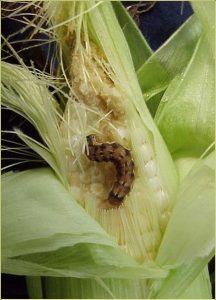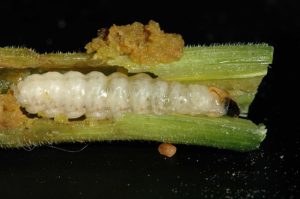Sweet Corn IPM Newsletter No. 5 — July 28, 2023
CORN EARWORM THREAT INCREASING
Early Corn Harvest Underway in Southern Maine

SITUATION
Corn harvest is underway in early fields planted under plastic mulch. Continued rain and wet ground has made pesticide and fertilizer applications difficult in many fields. Insect pest populations are generally higher this week, increasing the threat to silking corn. The distribution of pests so far this season is very spotty, being high in some locations and very low in others, with no real pattern emerging. This situation emphasizes the importance of monitoring pests in your own fields because pest populations can vary greatly from one site to another.
European corn borer: While larval feeding in pre-tassel corn increased in some fields this week, all were under threshold when measured by corn borer feeding alone. However, most fields also had feeding injury from corn earworm and/or fall armyworm, which put them over the control threshold of 15% injury. Moth counts also remained low at nearly all sites this week. The first generation of European corn borer usually starts to decline in midsummer. Occasionally we see a partial second generation emerge in September.

Corn earworm: Moth numbers were higher at most, but not all, locations this week, so most fresh silking corn requires some protection. We continue to see earworm feeding on whorl to pre-tassel plants, similar to fall army damage. This is counted, along with borer or armyworm damage, to determine if a pre-silking spray is warranted. Feeding was over the 15% infestation level at a site in Biddeford this week. Based on this week’s moth counts, a 4-day spray interval for silking corn was recommended for Auburn, Biddeford, Cape Elizabeth and Lewiston. A 5-day spray schedule was recommended for Bowdoinham, Dayton, Garland, New Gloucester, Sabattus and Wells. A 6-day spray interval was recommended for Farmington and one Dayton site.
Fall armyworm: Moths counts remain relatively low, with the exception of our sites in New Gloucester and Biddeford which were over the three moth threshold for silking corn. Low levels of larval feeding damage were found in pre-tassel corn, but only over threshold when combined with corn borer and corn earworm feeding.
Western Bean Cutworm: Moths were caught in pheromone traps at several locations this week. Larvae of western bean cutworms feed on corn plants and move into the ears through the silk channels or the husks, similar to fall armyworm. The threshold for feeding injury on plants is 8%. Sprays for corn earworm should protect silking corn from western bean cutworm as well. The optimal time for controlling the larvae is late pre-tassel to tassel.

Squash vine borer: Moth counts remain high at all locations this week. All sites were over the five moth threshold and sprays are recommended for all pumpkins and susceptible winter and summer squash types. Sprays should be targeted at the base of the plants where the moths lay their eggs. See the New England Vegetable Management Guide for control options.
Sincerely,
David T. Handley
Vegetable & Small Fruit Specialist
Highmoor Farm
P.O. Box 179
52 U.S. Route 202
Monmouth, ME 04259
207.933.2100
UMaine Extension Diagnostic Research Lab
Pest Management Unit
17 Godfrey Drive
Orono, ME 04473
1.800.287.0279
| Location | CEW Moths | ECB Moths | FAW Moths | %Feeding Damage | Recommendations / Comments |
|---|---|---|---|---|---|
| Auburn | 26 | 1 | 2 | 3% | 4-day interval recommended for silking corn |
| Biddeford | 8 | 1 | 3 | 15% | 4-day interval recommended for silking corn |
| Bowdoinham | 7 | 0 | 0 | 7% | 5-day interval recommended for silking corn |
| Cape Elizabeth | 17 | 0 | 0 | 6% | 4-day interval recommended for silking corn |
| Dayton I | 6 | 7 | 0 | 5% | 5-day interval recommended for silking corn |
| Dayton II | 2 | 0 | 1 | 13% | 6-day interval recommended for silking corn |
| Farmington | 2 | 0 | 1 | 13% | 6-day interval recommended for silking corn |
| Garland | 7 | 1 | 0 | 0% | 5-day interval recommended for silking corn |
| Lewiston | 11 | 0 | 1 | 5% | 4-day interval recommended for silking corn |
| Monmouth | 0 | 0 | 7 | — | No spray recommended (no silking corn) |
| New Gloucester | 6 | 0 | 10 | 4% | 5-day interval recommended for silking corn |
| Oxford | 0 | 0 | 0 | 0% | No spray recommended |
| Palmyra | 0 | 1 | 0 | 1% | No spray recommended |
| Sabattus | 4 | 0 | 0 | 0% | 5-day interval recommended for silking corn |
| Wayne | 0 | 0 | 1 | 2% | No spray recommended |
| Wells I | 4 | 0 | 0 | 14% | 5-day interval recommended for silking corn |
| Wells II | 6 | 0 | 0 | 0% | 5-day interval recommended for silking corn |
CEW: Corn earworm (Only fresh silking corn should be sprayed for this insect.)
ECB: European corn borer
FAW: Fall armyworm
| Moths caught per week | Moths caught per night | Spray Interval |
|---|---|---|
| 0.0 to 1.4 | 0.0 to 0.2 | No spray |
| 1.5 to 3.5 | 0.3 to 0.5 | Spray every 6 days |
| 3.6 to 7.0 | 0.6 to 1.0 | Spray every 5 days |
| 7.1 to 91 | 1.1 to 13.0 | Spray every 4 days |
| More than 91 | More than 13 | Spray every 3 days |
Thresholds apply only to corn with exposed fresh silk. Lengthen spray intervals by one day if maximum daily temperature is less than 80°F.
European Corn Borer Thresholds
Whorl stage: 30% or more of plants scouted show injury.
Pre-tassel-silk: 15% or more of plants scouted show injury.
Silk: 5 or more moths caught in pheromone traps in one week.
IPM Web Pages:
Explore Integrated Pest Management in Maine (UMaine)
Integrated Pest Management Data Visualization Tool (Penn State)
Integrated Pest Management (UMass Amherst)
Where brand names or company names are used, it is for the reader’s information. No endorsement is implied nor is any discrimination intended against other products with similar ingredients. Always consult product labels for rates, application instructions and safety precautions. Users of these products assume all associated risks.
The University of Maine is an equal opportunity/affirmative action institution.
